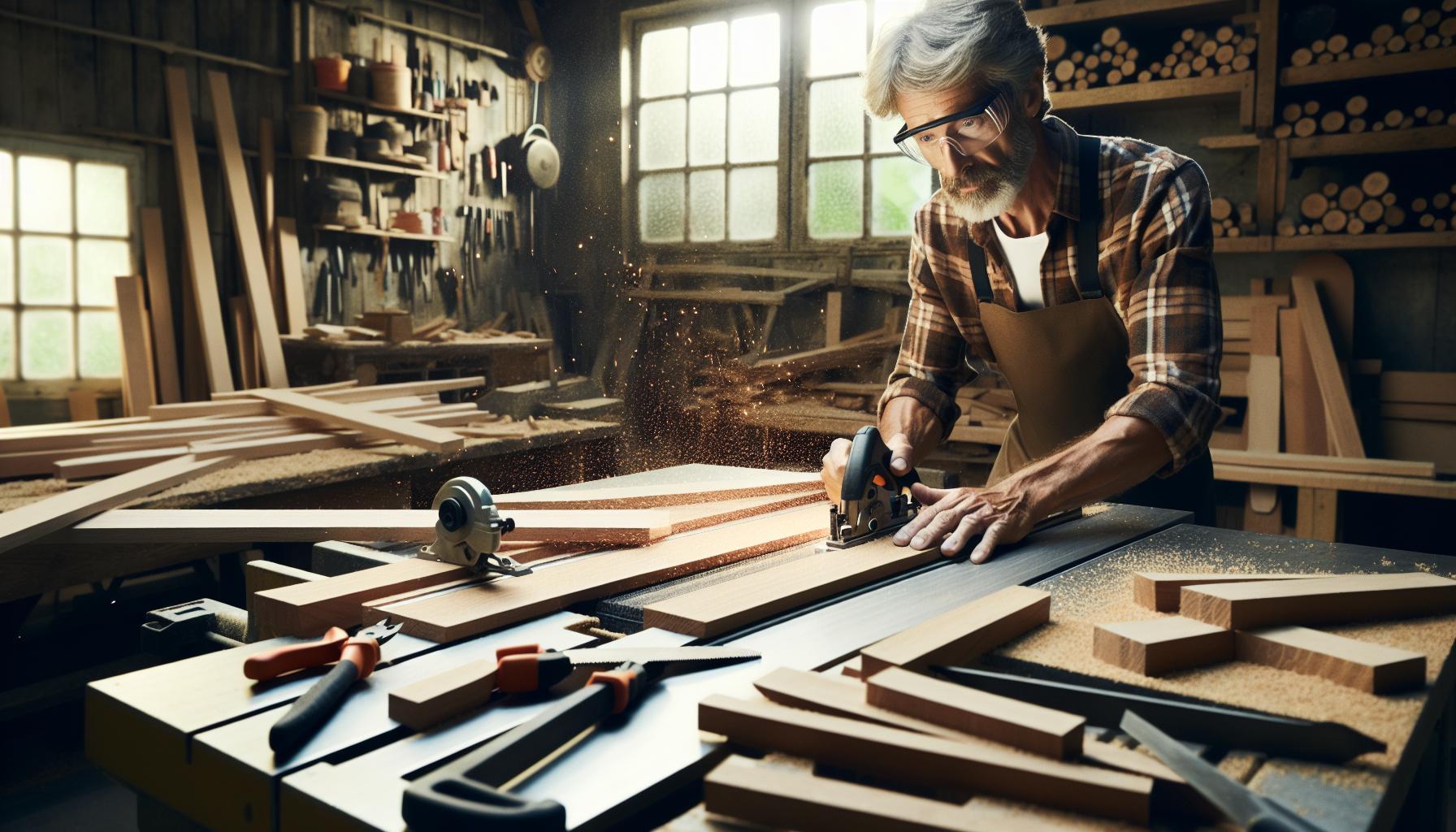There’s something incredibly satisfying about creating something with your own two hands. Woodwork DIY projects offer the perfect blend of creativity and practicality, allowing you to transform raw materials into functional art. Whether you’re a seasoned carpenter or a complete novice, diving into the world of woodworking can be both a rewarding hobby and a way to enhance your living space.
I’ve always found that the beauty of woodworking lies in its versatility. From crafting simple shelves to building intricate furniture, there’s a project for every skill level and interest. Plus, the sense of accomplishment that comes from completing a project is unmatched. As you explore various techniques and tools, you’ll not only develop new skills but also create unique pieces that reflect your personal style. So, let’s embark on this journey of creativity and craftsmanship, where the only limit is your imagination.
Key Takeaways
- Woodworking DIY projects blend creativity with practicality, allowing individuals to craft functional art pieces that reflect personal style and enhance living spaces.
- Beginners can start with basic tools like hammers and saws, while advanced woodworkers may utilize routers and table saws for more complex projects.
- Popular DIY projects include shelves, cabinets, outdoor furniture, and home decor items, suitable for various skill levels and offering opportunities for skill development.
- Selecting appropriate wood and adhering to safety practices, such as wearing protective gear, are essential for a successful and safe woodworking experience.
- Effective planning and precision techniques, like accurate measuring and proper joinery, are crucial for achieving impressive results in woodworking projects.
Woodwork DIY Projects
Woodwork DIY projects offer a unique blend of creativity and craftsmanship. They allow me to express myself while honing practical skills. Engaging in such projects, I bypass the constraints of mass-produced items, creating pieces that resonate with personal significance.
Different facets of woodworking attract various enthusiasts. Novices might start with joint-cutting techniques, crafting basic items like birdhouses or picture frames. As skills advance, more complex projects such as dovetail joints or custom tables become manageable challenges, offering opportunities to work with different tools and materials.
Key benefits also include enhancing my problem-solving abilities. When constructing a piece, I actively engage in planning and executing intricate designs. I learn to anticipate challenges, adapt plans, and find innovative solutions, which strengthens these critical skills.

Another appealing aspect is the cost-effectiveness. Procuring raw materials and converting them into finished projects can be more budget-friendly than buying similar ready-made pieces. If I upcycle or repurpose wood, it adds another layer of sustainability and creativity to the projects.
I also appreciate the therapeutic value of woodworking. The tactile nature of working with wood and witnessing the transformation from raw material to finished product can be deeply satisfying. This hands-on process encourages focus and mindfulness, providing a soothing escape from daily stressors.
By exploring woodwork DIY projects, I embark on a journey of continuous learning and self-expression.
Essential Tools for Woodworking
Woodworking demands a set of essential tools to transform ideas into tangible projects. With the right equipment, even beginners can start crafting their visions.
Basic Tools for Beginners
Starting woodworking requires fundamental tools that offer versatility. A tape measure provides precise measurements for accuracy in every project. With a hammer, you can drive nails or make adjustments with ease. A handsaw works for cutting through wood efficiently, especially in straightforward projects. Screwdrivers, including Phillips and flathead, fasten components together. Sandpaper smooths surfaces, ensuring a refined finish. A basic square checks angles and measurements for accurate alignment in your work.
Advanced Tools for Experienced Woodworkers

Experienced woodworkers integrate more sophisticated tools for complex projects. A router adds decorative edges and intricate designs to pieces. A table saw cuts larger pieces of wood with precision, assisting with expansive projects.
A power drill improves efficiency in creating holes or driving screws quickly. Chisels shape wood and achieve finer details in intricate designs. A planer ensures uniform thickness for boards, creating smooth and even surfaces for assembly.
Popular Woodwork DIY Project Ideas
Exploring woodwork DIY projects opens a world of possibilities and creativity. By crafting various items, I enhance my skills and create practical and aesthetic solutions for everyday needs.
Shelves and Cabinets
Shelves and cabinets stand as versatile projects perfect for honing woodworking skills. I can create floating shelves to add storage without occupying floor space. For a more advanced task, crafting a custom-made cabinet allows me to experiment with design elements like door styles and shelving layouts. Using quality wood ensures durability, while selecting different finishes can tailor the appearance to match any interior.
Outdoor Furniture
Creating outdoor furniture marries functionality with artistry. I often build simple picnic tables or benches, and for more intricate projects, I explore Adirondack chairs that demand precise cutting angles. Using weather-resistant wood like cedar or teak enhances longevity. Adding a protective sealant helps sustain the furniture’s beauty against the elements.
Home Decor and Accessories
Crafting home decor lets me personalize living spaces. Wall art and picture frames offer creative outlets using reclaimed wood or off-cuts. Smaller projects like wooden clocks or coasters demand less material but provide ample opportunity for skill refinement. Incorporating carving or wood-burning techniques adds a unique touch to these pieces, bridging practicality with personal style.
Materials and Safety Tips

Understanding the essential materials and adhering to safety tips ensure a successful woodworking journey. Selecting the right wood and practicing safety are crucial steps.
Choosing suitable wood types for projects impacts quality and durability. Hardwoods, like oak and maple, offer strength and longevity, ideal for furniture. Softwoods, such as pine and cedar, provide ease of use for beginners. Reclaimed wood adds character and supports sustainability efforts. Consider grain, texture, and intended use to match your project’s requirements.
Safety Practices in Woodworking
Ensuring safety in woodworking prevents accidents and injuries. Wear protective gear—safety goggles, gloves, and dust masks shield eyes, skin, and lungs. Keep your workspace organized to minimize hazards when maneuvering tools and materials. Follow proper procedures when operating power tools, adhering to manufacturer instructions. Maintain tools regularly for optimal function. Prioritizing these practices fosters a safe and productive woodworking environment.
Tips for Successful Woodwork Projects
Achieving success in woodworking requires meticulous planning and precision. These strategies will guide you in creating impressive DIY projects.
Planning and Designing
Effective planning forms the backbone of any woodworking project. Start by sketching your ideas on paper, detailing dimensions and specific features. Prioritize materials by selecting appropriate wood, considering factors like durability and aesthetics. Ensure measurements are precise, as minor errors can cause significant issues during assembly. Use design software tools like SketchUp for complex projects to visualize the final outcome. Always incorporate a budget, factoring in supplies, tools, and unforeseen expenses.
Techniques for Precision
Precision elevates the quality of woodwork, turning ordinary into exceptional. Utilize measuring tools like calipers and squares for exact marking. Ensure clean cuts by using sharp, well-maintained saw blades. Practice using jigs and templates to achieve consistent results, especially for repeated shapes. When drilling, mark pilot holes to prevent wood from splitting. Sand surfaces in multiple grits for smooth finishes that highlight the wood’s natural beauty. Pay attention to joinery techniques, opting for dovetail or mortise-and-tenon joints for strength and elegance in construction.
Embarking on woodworking DIY projects offers a fulfilling blend of creativity and practicality. With the right tools and materials, anyone can transform ideas into beautiful, functional pieces. As you hone your skills, remember that each project is an opportunity to express your unique style and learn something new. Safety and planning are key to a successful woodworking journey, ensuring that you enjoy the process while creating lasting works of art. Whether you’re crafting simple shelves or intricate furniture, the satisfaction of building with your own hands is unparalleled. Dive into this rewarding hobby and let your creativity shine.



